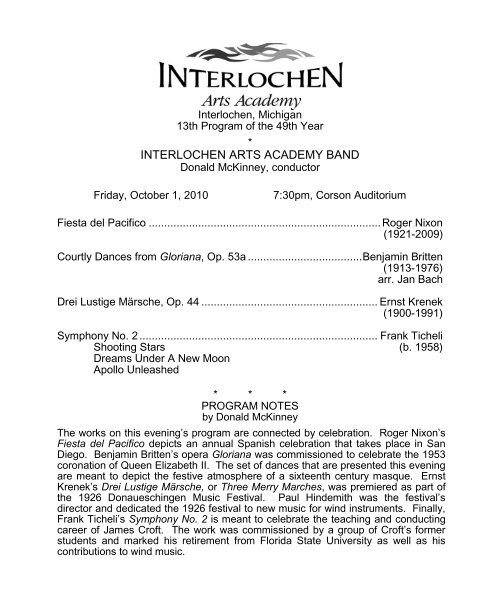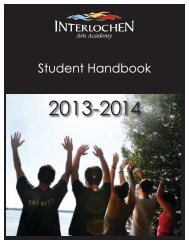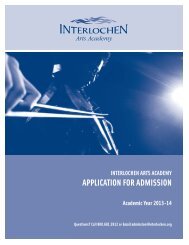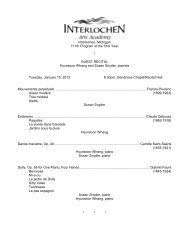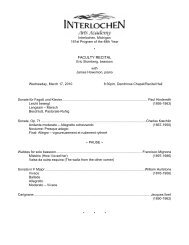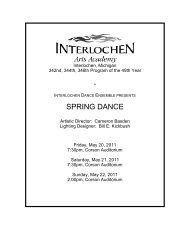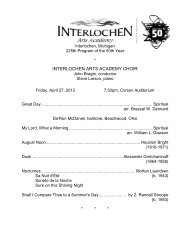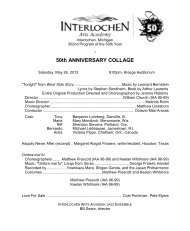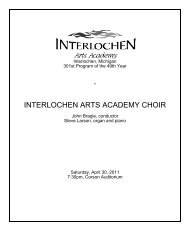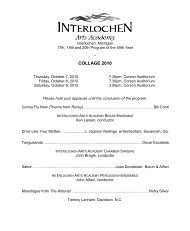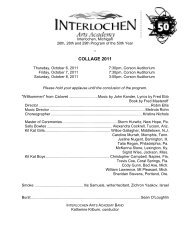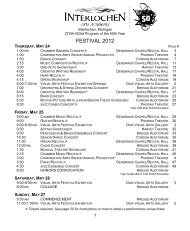13 Band 10-1.pdf - Arts Academy High School
13 Band 10-1.pdf - Arts Academy High School
13 Band 10-1.pdf - Arts Academy High School
Create successful ePaper yourself
Turn your PDF publications into a flip-book with our unique Google optimized e-Paper software.
Interlochen, Michigan<br />
<strong>13</strong>th Program of the 49th Year<br />
*<br />
INTERLOCHEN ARTS ACADEMY BAND<br />
Donald McKinney, conductor<br />
Friday, October 1, 20<strong>10</strong> 7:30pm, Corson Auditorium<br />
Fiesta del Pacifico ........................................................................... Roger Nixon<br />
(1921-2009)<br />
Courtly Dances from Gloriana, Op. 53a ..................................... Benjamin Britten<br />
(19<strong>13</strong>-1976)<br />
arr. Jan Bach<br />
Drei Lustige Märsche, Op. 44 ......................................................... Ernst Krenek<br />
(1900-1991)<br />
Symphony No. 2 ............................................................................. Frank Ticheli<br />
Shooting Stars (b. 1958)<br />
Dreams Under A New Moon<br />
Apollo Unleashed<br />
* * *<br />
PROGRAM NOTES<br />
by Donald McKinney<br />
The works on this evening’s program are connected by celebration. Roger Nixon’s<br />
Fiesta del Pacifico depicts an annual Spanish celebration that takes place in San<br />
Diego. Benjamin Britten’s opera Gloriana was commissioned to celebrate the 1953<br />
coronation of Queen Elizabeth II. The set of dances that are presented this evening<br />
are meant to depict the festive atmosphere of a sixteenth century masque. Ernst<br />
Krenek’s Drei Lustige Märsche, or Three Merry Marches, was premiered as part of<br />
the 1926 Donaueschingen Music Festival. Paul Hindemith was the festival’s<br />
director and dedicated the 1926 festival to new music for wind instruments. Finally,<br />
Frank Ticheli’s Symphony No. 2 is meant to celebrate the teaching and conducting<br />
career of James Croft. The work was commissioned by a group of Croft’s former<br />
students and marked his retirement from Florida State University as well as his<br />
contributions to wind music.
Fiesta del Pacifico (1960) Roger Nixon<br />
Fiesta del Pacifico is one of several festivals held annually in various communities in<br />
California, which celebrate the Old Spanish Days in the State. This particular festival is<br />
held in San Diego for twelve days in the summer, and features a play on the history of the<br />
area with a cast of over a thousand, a parade, a rodeo, and street dances. Born and<br />
raised in California's Central Valley towns of Tulare and Modesto, Roger Nixon acquired a<br />
taste for the rhythms and dances of the early settlers of the state, and they appear in many<br />
of his works. He obtained his Ph.D. from the University of California at Berkeley and joined<br />
the faculty at San Francisco State University in 1960. His teachers were Arthur Bliss,<br />
Ernst Bloch, and Arnold Schoenberg.<br />
Courtly Dances from Gloriana, Op. 53a (1953) Benjamin Britten<br />
Benjamin Britten’s seventh opera, Gloriana, was commissioned by Covent Garden to<br />
celebrate the Coronation of Queen Elizabeth II in June 1953. The libretto was by William<br />
Plomer, after the book "Elizabeth and Essex" by Lytton Strachey. Heavily criticized after its<br />
first performance, Gloriana has never found a permanent niche in opera houses. The<br />
criticism was mainly aimed at the opera's scenario, which tended to highlight the Queen's<br />
frailties, her personal relationship with the Earl of Essex, and the intrigues and jealousies<br />
at Court. It was thought that the persona of Queen Elizabeth I of England should have<br />
been portrayed as the monarch of a burgeoning European power. Britten was also<br />
criticized for choosing to close the opera with the spoken word, rather than musically.<br />
The Courtly Dances appear in the third scene of Act II. In the Great Room of Whitehall<br />
Palace, the Queen is giving a ball. Accompanied by a stage band, the curtain rises on a<br />
stately Pavane, followed by a Galliard. The Queen enters and upon catching sight of the<br />
Countess of Essex, her jealous rival, she commands a La Volta - a vigorous dance during<br />
which their partners toss the ladies in the air. It is so vigorous in fact that at its end the<br />
Queen further commands that the "Ladies, go change thy linen"! Meanwhile a Morris<br />
Dance is performed to entertain those who remain in the room. Britten subsequently<br />
compiled the music from this scene into a symphonic suite.<br />
Drei Lustige Märsche, Op. 44 (1924-26) Ernst Krenek<br />
One of the most prolific composers of the twentieth century, composer Ernst Krenek wrote<br />
in a wide variety of idioms. Described as “stylistically unstable,” Krenek experimented<br />
throughout his career with many different manners of writing. He held Paul Hindemith in<br />
high esteem in the early 1920s, however he eventually came to reject Hindemith's notion of<br />
Gebrauchsmusik, writing, “the making of music should be left to the highly trained, while<br />
children and amateurs should be schooled to appreciate it.” After the Nazis annexed<br />
Austria in 1938, Krenek immigrated to the United States where he would become an<br />
influential author and teacher.<br />
John Carmichael has written the following about the work:<br />
Drei Lustige Märsche is a collection of march parodies. As his response to<br />
Hindemith's commission, Krenek submitted this composition, which pokes fun at the<br />
typical military music of the day. From the stilted percussion introductions to the<br />
disguised quotes of well-known tunes, like "Mexican Hat Dance," and "Can-Can,"<br />
Krenek teases the present and the past, while pointing a finger to the possibilities of<br />
the future.
Satirical and at times downright grotesque, these marches demonstrate Krenek's life-long<br />
dislike of the military. Although traditional march rhythms and forms are employed, Krenek<br />
seems interested in mocking the repertoire of the military bands by incorporating nonmilitary<br />
elements.<br />
Symphony No. 2 (2004) Frank Ticheli<br />
The symphony’s three movements refer to celestial light – Shooting Stars, the Moon, and<br />
the Sun. Although the title for the first movement, "Shooting Stars," came after its<br />
completion, I was imagining such quick flashes of color throughout the creative process.<br />
White-note clusters are sprinkled everywhere, like streaks of bright light. <strong>High</strong> above, the<br />
E-flat clarinet shouts out the main theme, while underneath, the low brasses punch out<br />
staccatissimo chords that intensify the dance-like energy. Fleeting events of many kinds<br />
are cut and pasted at unexpected moments, keeping the ear on its toes. The movement<br />
burns quickly, and ends explosively, scarcely leaving a trail.<br />
The second movement, "Dreams Under a New Moon," depicts a kind of journey of the soul<br />
as represented by a series of dreams. A bluesy clarinet melody is answered by a chantlike<br />
theme in muted trumpet and piccolo. Many dream episodes follow, ranging from the<br />
mysterious, to the dark, to the peaceful and healing. A sense of hope begins to assert itself<br />
as rising lines are passed from one instrument to another. Modulation after modulation<br />
occurs as the music lifts and searches for resolution. Near the end, the main theme returns<br />
in counterpoint with the chant, building to a majestic climax, then falling to a peaceful coda.<br />
The final B-flat major chord is colored by a questioning G-flat.<br />
The finale, "Apollo Unleashed," is perhaps the most wide-ranging movement of the<br />
symphony, and certainly the most difficult to convey in words. On the one hand, the image<br />
of Apollo, the powerful ancient god of the sun, inspired not only the movement's title, but<br />
also its blazing energy. Bright sonorities, fast tempos, and galloping rhythms combine to<br />
give a sense of urgency that one often expects from a symphonic finale. On the other<br />
hand, its boisterous nature is also tempered and enriched by another, more sublime force,<br />
Bach's Chorale BWV 433 (Wer Gott vertraut, hat wohl gebaut). This chorale--a favorite of<br />
the dedicatee, and one he himself arranged for chorus and band--serves as a kind of<br />
spiritual anchor, giving a soul to the gregarious foreground events. The chorale is in<br />
ternary form (ABA'). In the first half of the movement, the chorale's A and B sections are<br />
stated nobly underneath faster paced music, while the final A section is saved for the<br />
climactic ending, sounding against a flurry of sixteenth-notes.<br />
~Program note by Frank Ticheli<br />
* * *<br />
In consideration of the performing artists and other patrons, the use of flash photography is not permitted.<br />
Federal copyright and licensing rules prohibit the use of video cameras and other recording equipment.<br />
In order to provide a safe and healthy environment, Interlochen maintains a smoke-free and alcohol-free campus.<br />
Michigan law prohibits any weapons, including concealed weapons, on Interlochen property<br />
because we are an educational campus. Thank you for your cooperation.<br />
www.interlochen.org
DONALD MCKINNEY is the band conductor at Interlochen <strong>Arts</strong> <strong>Academy</strong>. Previously, he was<br />
the associate conductor of ensembles at the Duquesne University <strong>School</strong> of Music where he<br />
worked with the wind ensembles, orchestra, and opera workshop. He was also the assistant<br />
conductor to violinist and conductor Sidney Harth and was responsible for teaching courses in<br />
undergraduate conducting. After participating in the Second Frederick Fennell Conducting<br />
Master Class, he was named a finalist for the Thelma A. Robinson Award by the Conductors<br />
Guild. Dr. McKinney has participated in numerous conducting symposiums including New<br />
England Conservatory, University of North Texas, University of Minnesota, and the Conductors<br />
Institute of South Carolina. He has published several articles including an upcoming chapter in<br />
Women of Influence in Contemporary Music. He received the doctor of musical arts degree in<br />
conducting from the University of Michigan and his primary conducting teachers include<br />
Michael Haithcock, Jack Stamp, and Robert Cameron. He has also completed additional study<br />
with H. Robert Reynolds and Frank Battisti.<br />
FLUTE<br />
Jing Ping He, Fla. (piccolo) <<br />
Kyung Ho Ko, South Korea~<br />
Ashley Jackson, Ky. +<br />
Margaret Brennan, Mich.<br />
Haley Stickney, Fla. (piccolo) ^<br />
Marissa Cecil, Ky.<br />
Jae Eun Choi, South Korea<br />
Jessica Wallace, Mich.<br />
Minsun Park, South Korea<br />
OBOE<br />
Cara Tunstall, La. +~<<br />
Wentao Jiang, China^<br />
Dov Stanley, Wyo.<br />
Betty Murphy, Ohio<br />
E-FLAT CLARINET<br />
Charles Sonoda, Calif. <<br />
CLARINET<br />
Morgan Kent, La. +<<br />
April Benlein, N.M. ~<br />
Taylor Marino, N.C. ^<<br />
Francisco Brunner, Chile<br />
Lingchen Li, China<<br />
Matthew Hughes, Texas<br />
Trevor Sparks, Ala.<br />
Erin Kim, South Korea<br />
BASS CLARINET<br />
Brandon Konnow, Wis.<br />
* * *<br />
INTERLOCHEN ARTS ACADEMY BAND<br />
J Berry, manager<br />
BASSOON<br />
Molly Murphy, Mass. *<br />
Samantha Chau, Mich.<br />
Emily Blandon Kovar, Fla.<br />
Peng Zhang, China<br />
ALTO SAXOPHONE<br />
Sapphire Adizes, Calif. *<br />
Henry Solomon, Calif.<br />
TENOR SAXOPHONE<br />
Taylor Matta, Ariz.<br />
BARITONE SAXOPHONE<br />
Bill Sears, IAA faculty<br />
TRUMPET<br />
David Koch, Mich. *<<br />
C. Martin DeFrance, Miss. <<br />
Samuel Botstein, N.J.<br />
Robert Marx, Hawaii<br />
Marianella Cordoba, Costa Rica<br />
HORN<br />
Hirofumi Tanaka, Japan*<<br />
Clayton Ellis, Calif. <<br />
William Kovaleski, Ohio<br />
Philip Brindise, Fla.<br />
Mateusz Jagiello, Poland<br />
* Principal<br />
^ Principal for Nixon<br />
TROMBONE<br />
Zongxi Li, China*<<br />
Lena Piazza-Leman, Mo.<br />
Katjana Nagel, Mich.<br />
Kedrik Merwin, IAA faculty<br />
EUPHONIUM<br />
Sydney Richardson, Ind. *<br />
Matthew Stumpff, Mich.<br />
TUBA<br />
Davis Erickson, Ill. *<<br />
Akshat Jain, India<br />
HARP<br />
Charles Overton, Va. *<br />
Johanna Wienholts, Ohio<br />
Rachel Swinehart, Iowa<br />
CELESTE<br />
Joseph McNamara, Fla.<br />
PERCUSSION<br />
Evan Saddler, Iowa<<br />
Chelsea Elder, Ohio<br />
Noah McKee, Calif. +~<br />
G. Donnie Spackman, Pa. <<br />
Rose Egan, Pa. ^<<br />
Skye Gunter, N.Y. <<br />
+ Principal for Britten<br />
~ Principal for Ticheli<br />
< Playing for Krenek


